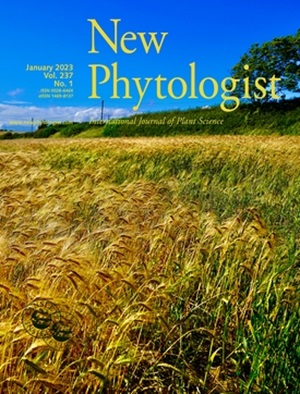Alternative transcriptional initiation of OsβCA1 produces three distinct subcellular localization isoforms involved in stomatal response regulation and photosynthesis in rice
IF 8.3
1区 生物学
Q1 PLANT SCIENCES
引用次数: 0
Abstract
- Plants adjust the size of their stomatal openings to balance CO2 intake and water loss. Carbonic anhydrases (CAs) facilitate the conversion between CO2 and HCO3−, and the OsβCA1 mutant in rice (Oryza sativa) shows similar traits in carbon fixation and stomatal response to CO2 as the dual βCA mutants in Arabidopsis thaliana. However, the exact role of OsβCA1 in these processes was unclear.
- We used gene editing, molecular biology, and plant physiology to study how OsβCA1 contributes to carbon fixation, stomatal opening, and CO2 responses.
- OsβCA1 produces three isoforms (OsβCA1A, OsβCA1B, and OsβCA1C) through alternative transcriptional initiation, which localize to the chloroplast, cell membrane, and cytosol, respectively. Protein measurements revealed that OsβCA1A/C and OsβCA1B contribute 97 and 3% to OsβCA1, respectively. By creating specific mutants for each isoform, our results found that the chloroplast and cell membrane isoforms independently participate in carbon fixation and regulation of stomatal aperture. Furthermore, the complete knockout of OsβCA1 caused a delayed response to low CO2.
- Our findings provide new insights into the generation and function of different OsβCA1 isoforms, clarifying their roles in CO2 diffusion, CO2 fixation and stomatal regulation in rice.
求助全文
约1分钟内获得全文
求助全文
来源期刊

New Phytologist
生物-植物科学
自引率
5.30%
发文量
728
期刊介绍:
New Phytologist is an international electronic journal published 24 times a year. It is owned by the New Phytologist Foundation, a non-profit-making charitable organization dedicated to promoting plant science. The journal publishes excellent, novel, rigorous, and timely research and scholarship in plant science and its applications. The articles cover topics in five sections: Physiology & Development, Environment, Interaction, Evolution, and Transformative Plant Biotechnology. These sections encompass intracellular processes, global environmental change, and encourage cross-disciplinary approaches. The journal recognizes the use of techniques from molecular and cell biology, functional genomics, modeling, and system-based approaches in plant science. Abstracting and Indexing Information for New Phytologist includes Academic Search, AgBiotech News & Information, Agroforestry Abstracts, Biochemistry & Biophysics Citation Index, Botanical Pesticides, CAB Abstracts®, Environment Index, Global Health, and Plant Breeding Abstracts, and others.
 求助内容:
求助内容: 应助结果提醒方式:
应助结果提醒方式:


